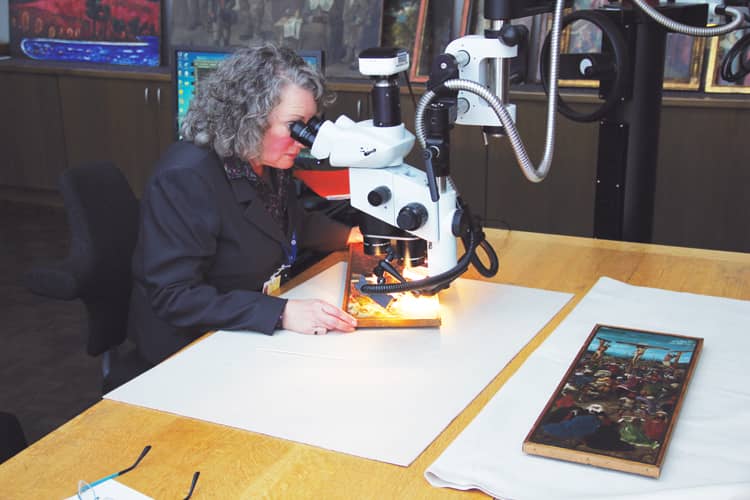
By Anne W. Semmes
Sentinel Features Reporter

Maryan Ainsworth of Old Greenwich has hung her hat at the Metropolitan Museum of Art for a long time—the last 14 years as curator of European paintings—but not as long as that pair of famous Jan Van Eycks, “Crucifixion and Last Judgment,” have hung together at the Met.
The Van Eycks came to the Met in 1933 in all of their extraordinary detail by way of the Hermitage in Russia, for a bargain price of $185,000 considering that Van Eyck is one of history’s greatest oil painters. Paul Mellon was not so lucky. He paid over a half million for Van Eyck’s “Annunciation,” now hanging at the National Gallery.
“Crucifixion and Last Judgment” are considered as one work under the banner of a new “Focus” show at the Met—“A New Look at a Van Eyck Masterpiece”—on view until April 24. Maryan’s intriguing discoveries, in partnership with the Met’s Department of Painting Conservation, are also on view.
A little background first. The Van Eycks, dating to 1440-1441, are smallish, 22 and one-quarter inches by seven and three-quarter inches, and were likely commissioned as devotionals—an impressive step up from an illuminated manuscript. They are described as a diptych, built to fold together and carry under the arm. Their brass leaf frames include curiously unique Latin Biblical texts running around the frames—a pertinent text from Isaiah surrounds “Crucifixion, “while a text from Revelation and Deuteronomy surrounds “Last Judgment.” Maryan points out that Van Eyck exactly aligned the texts to what is going on in the paintings.
Incredibly, Maryan tells how the Hermitage, because of its inadequate temperature controls at the time, chose to transfer the two paintings from their wood panels onto canvas. How? “They planed off the wooden back of the panel literally to the veneer, the painted layer.” That layer is then magically affixed by adhesive onto fine linen or canvas. “No one would do that today,” she adds.
That transfer stole away the grisaille images known to have been painted on the back panel of each painting.
But the paintings carried with them a lingering mystery. Was there a missing panel meant to exist between “Crucifixion” and “Last Judgment”? Had Van Eyck indeed created a triptych? Thus Maryan’s sleuthing began three years ago—with the help of the Met’s high tech tool of infrared reflectography. Her first discoveries she shared at scholarly conferences; she and her conservators had found more text located beneath the frames’ brass coating, which were the same Biblical passages, but in the Flemish vernacular of that time. A democratic touch by the artist.
Around this time, a Netherlands drawing surfaced in an exhibit at the Rotterdam Museum that Maryan had long had a photo of in her files. The drawing, very similar to Van Eyck’s Crucifixion, had been bought by a Dutch psychiatrist at an estate sale who paid about $5, convinced that it was kin to the Van Eyck Crucifixion in the Metropolitan.
“He’d spent a lifetime trying to prove it was by Van Eyck’s older brother Hubert,” notes Maryan.
But it is younger brother Jan Van Eyck the Met has settled on. “The drawing is either by Van Eyck or someone from his workshop,” says Maryan. On view at Maryan’s Focus show, the drawing has a varnished surface in keeping with a likely workshop model meant to be preserved and used, says Maryan, “perhaps for Van Eyck’s ‘Crucifixion,’ and for paintings and illuminated manuscripts long after he died.”

Maryan shows the connection between the drawing and Van Eyck’s “Crucifixion.” She points to the figure of the Virgin Mary and St. John in the lower half of the painting. “You see how he is working out the relationships in the faces.” The drawing has Mary looking rather severe; the painting has her less so, but more hidden. “The drawing and the painting are so closely connected,” she says. “It has to be the same person or someone in his workshop.”
Other discoveries followed under the rays of x-radiography—“very old” nail holes in the frames that could indicate a third, missing panel. But no third panel has been found of the right size with relevant subject, with the same human scale of figures as found in “Crucifixion and Last Judgment.” So, Maryan does not buy the triptych idea. Her theory is the two paintings framed a tabernacle. “I think this is a real possibility she says,” but the sleuth cautions, “This is a work in progress.”
Viewers alert: In the show, the paintings are in temporary frames with the real ones displayed—the original brass leaf frame, and the other with the brass removed showing the under text and some of the original red color of the frames.
It seems that Naples nobility got their hands on the paintings, and reframed them to their liking, covering the red with their gold frames. A work of art will be prey to a lot of changes not intended by the artist. But Maryan’s intentions are, at show’s end, to return the frames to their original state, to allow the underlying text to be seen.
Maryan has come to know intimately Van Eyck’s greatest works—she’s part of a group overseeing the restoration of his most famous Ghent Altarpiece. She can readily discern in the upper half of the Met’s “Last Judgment” where the finely delineated brush of Van Eyck is missing. She compares the archangel Michael in the top half of the painting to another angel lower down. “He is not as refined as the Archangel,” she says, adding, “The artist is likely from Van Eyck’s workshop.”
She marvels, as we all do, at the extraordinary detail with which Van Eyck paints in one the deep despair of Christ’s death, and in the other the triumph of his rising. “The Crucifixion is happening in real time,” she notes. “He’s painted in the moon, the fading light of day, an indication of time and place, the backdrop of mountains, the city of Jerusalem.”
“There are people jeering and laughing and ridiculing, and crying,” she notes of the crowd surrounding the three crosses. But “If you are kneeling in front of this painting, taking in the words and images together, you can see the emotional anguish of St. John and the Virgin Mary. These paintings were made as devotional aids, for devotional prayer, to inspire devotion. They represent how you should be acting. The figure with its back to you is you, drawing you more intimately into the painting. You are there.”
And then Maryan speaks to her curatorial duty. “What is most important is to try to rediscover what the artwork meant in its own time. In order to make that discovery, you need to examine the painting with your own eyes, but with technical tools as to how and why the painting was made, and why it looks like it does. That gets us closer to the artist in time.”




